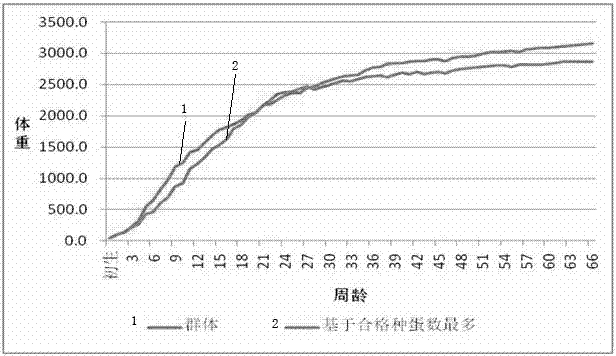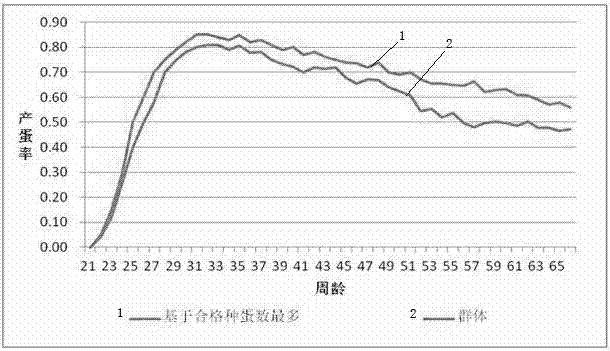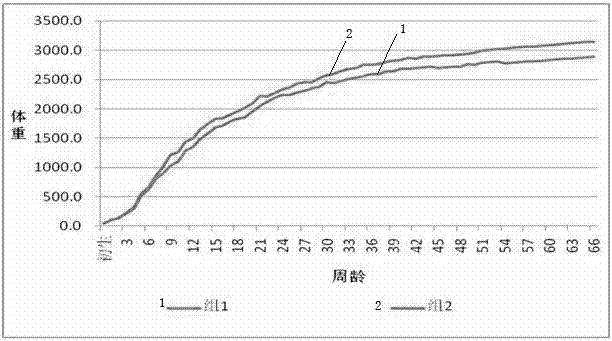Study method for growth-development rule based on breeding hens with maximum qualified hatching egg quantity
A growth and development and egg-laying technology, which is applied in the research field of the growth and development law of breeders, can solve the problems of evaluating the pros and cons of growth and development, and achieve the effects of improving egg production quality, egg production rate and economic benefit.
- Summary
- Abstract
- Description
- Claims
- Application Information
AI Technical Summary
Problems solved by technology
Method used
Image
Examples
Embodiment 1
[0022] 1. Choose 1600 sets or more of Suqin Yellow Chicken No. 2 parental seedlings, wear wing numbers, weigh the birth weight and record the corresponding wing numbers; caged throughout the entire process, with routine nutritional levels, environmental conditions and management measures.
[0023] 2, 0-3 weeks of age, free intake, 4 weeks of age, 1440 or more hens of similar body weight are randomly divided into 8 groups, each group has 4-6 repeats, and each repeat has more than 30; 4-20 The 8 week-old groups were fed with 65%, 70%, 75%, 80%, 85%, 90%, 95%, 100% of the free intake, and they were transferred to laying eggs at the beginning of 21 weeks of age with each repeat as a unit Chicken house: From 21 weeks of age, each chicken in each group will be added 1g of feed per day at the same time, and the peak feed rate will be reached when the egg production rate is 35%; after 36 weeks of age, each chicken will lose 0.5g of feed per week.
[0024] 3. For 1-40 weeks of age, measure ...
Embodiment 2
[0039] 1. Choose 1600 sets or more of Suqin green-shell layer parental generation mother seedlings, wear wing numbers, weigh the birth weight and record the corresponding wing numbers; raise them in cages throughout the entire process, with routine nutritional levels, environmental conditions and management measures.
[0040] 2, 0-6 weeks of age, ad libitum, 7 weeks of age, 1440 or more Suqin green shell layer parental seedlings of similar body weight were randomly divided into 8 groups, each with 4-6 replicates, each There are more than 30 repetitions; 8 groups of 7-18 weeks of age were fed with 65%, 70%, 75%, 80%, 85%, 90%, 95%, 100% of ad libitum intake. Each repetition is transferred to the laying hen house; starting from 19 weeks of age, ad libitum, 46-66 weeks of age, each chicken in each group will be reduced by 0.5g every two weeks.
[0041] 3. For 1-40 weeks of age, measure the consumption of each repetition of each group every week, and measure the average weight of each ...
PUM
 Login to View More
Login to View More Abstract
Description
Claims
Application Information
 Login to View More
Login to View More - R&D Engineer
- R&D Manager
- IP Professional
- Industry Leading Data Capabilities
- Powerful AI technology
- Patent DNA Extraction
Browse by: Latest US Patents, China's latest patents, Technical Efficacy Thesaurus, Application Domain, Technology Topic, Popular Technical Reports.
© 2024 PatSnap. All rights reserved.Legal|Privacy policy|Modern Slavery Act Transparency Statement|Sitemap|About US| Contact US: help@patsnap.com










